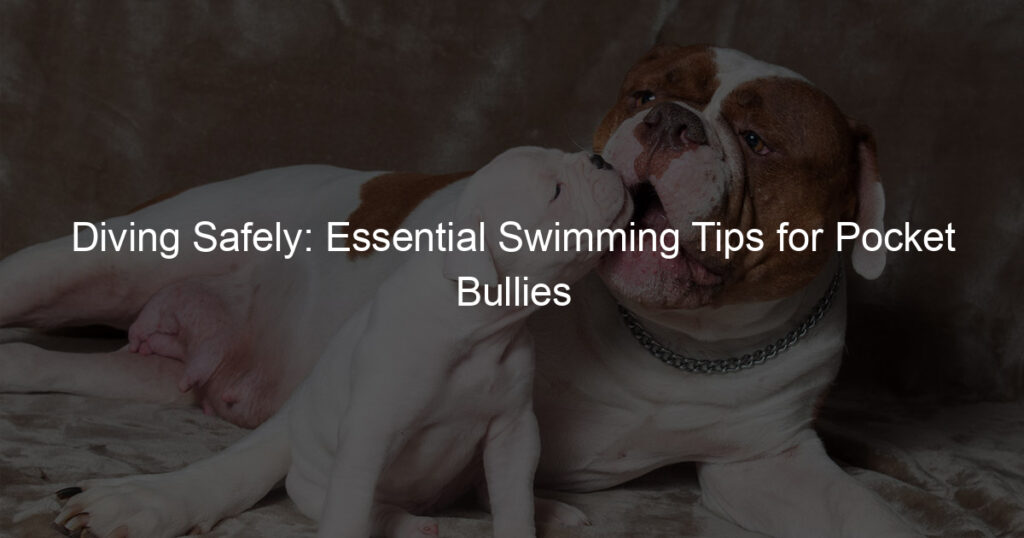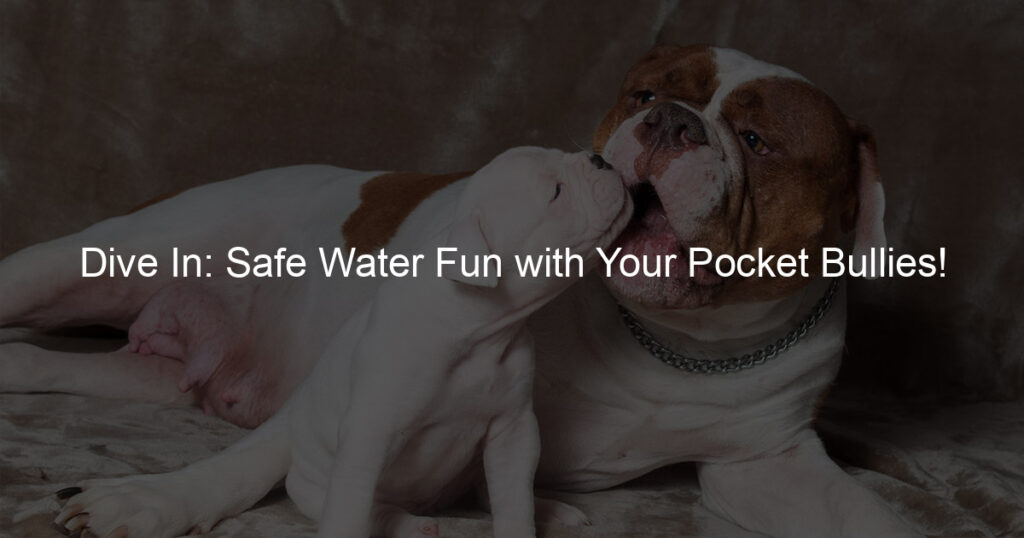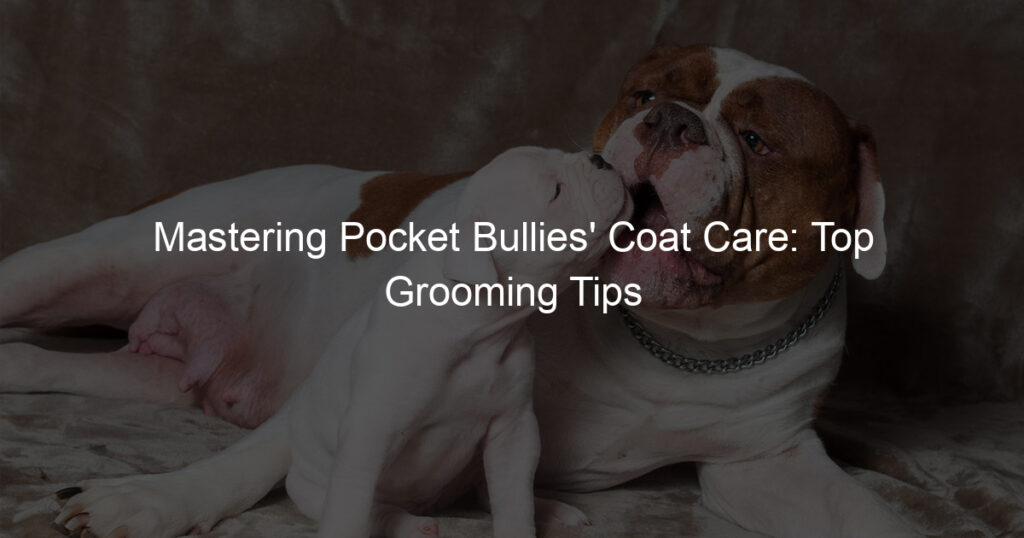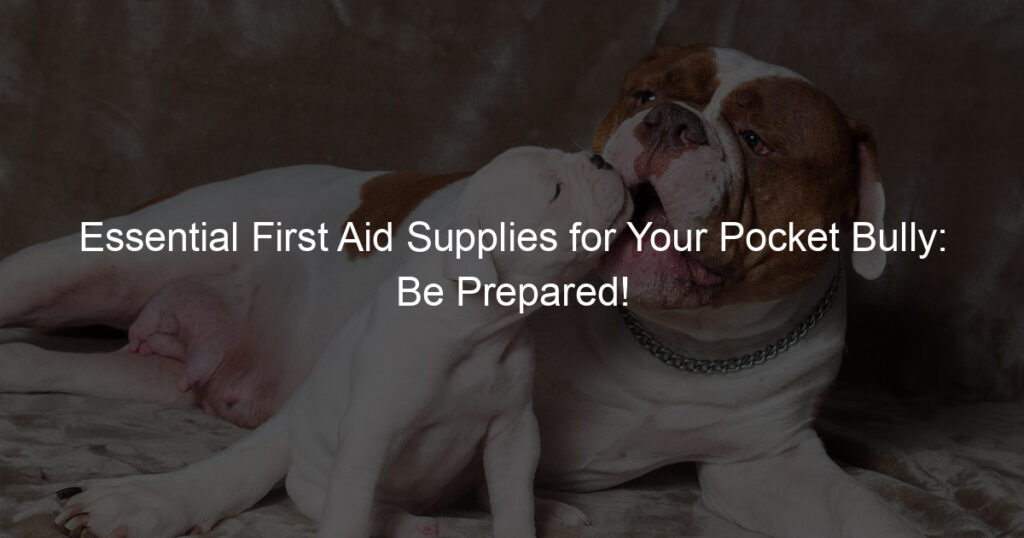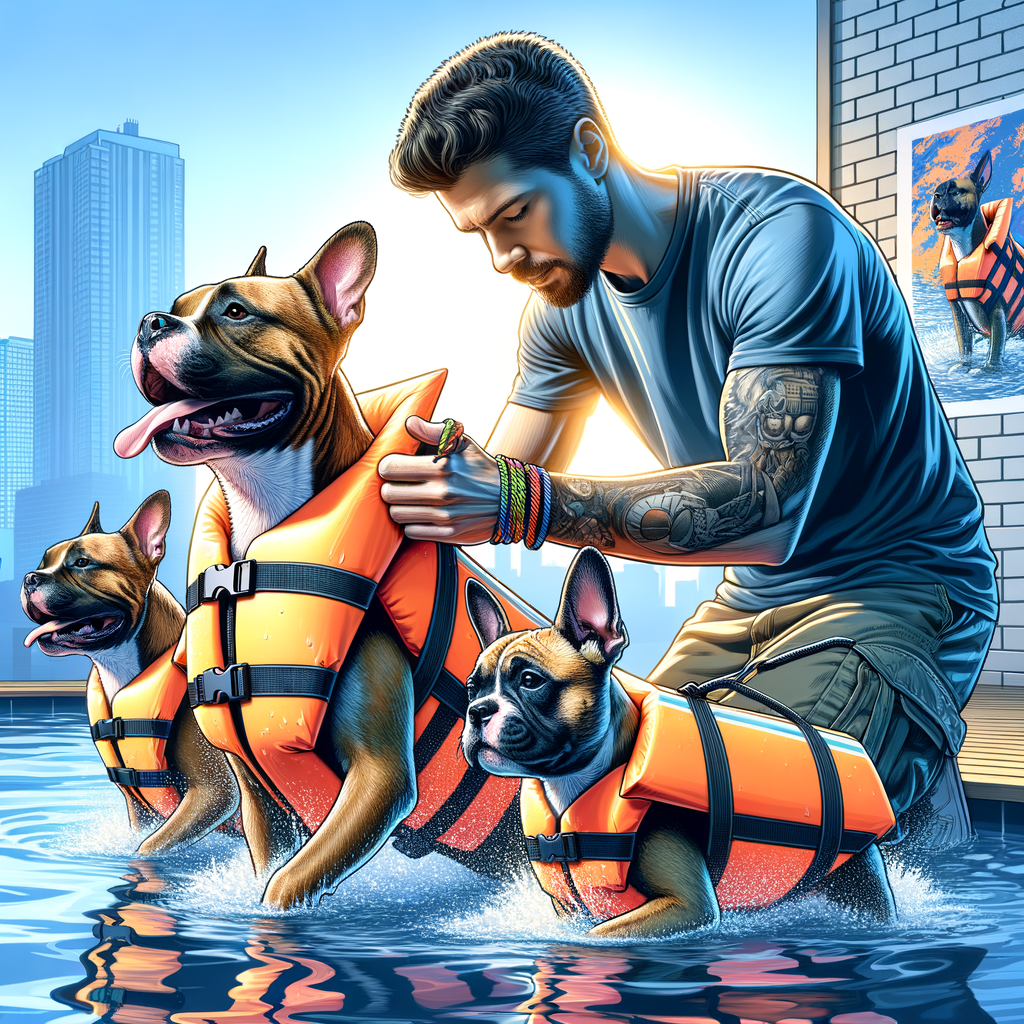
Introduction to Pocket Bullies and Water Safety
Welcome to our comprehensive guide on Pocket Bullies and water safety. This guide is designed to provide you with essential information about this unique breed and the importance of water safety for them. Let’s dive in!
- Understanding the breed: Pocket Bullies
- Why water safety is crucial for Pocket Bullies
Pocket Bullies, also known as Miniature American Bullies, are a small, muscular, and compact breed of dogs. They are known for their friendly and protective nature, making them a popular choice for families. Despite their intimidating appearance, Pocket Bullies are incredibly gentle and affectionate, especially towards their human families.
These dogs are energetic and love to play, which often includes activities involving water. However, their compact body structure and short snout can make swimming a bit challenging for them. That’s why it’s crucial to understand their physical limitations and ensure their safety around water.
Water safety is vital for all dogs, but it’s particularly important for breeds like Pocket Bullies. Their short snout and heavy muscular body can make it hard for them to keep their head above water, increasing the risk of water-related accidents.
Moreover, many Pocket Bullies are naturally drawn to water and may instinctively jump into a pool or other body of water without understanding the risks. This makes it even more essential to teach them water safety rules and ensure they are closely supervised around water.
Remember, a safe dog is a happy dog. By understanding the breed and ensuring water safety, you can help your Pocket Bully enjoy a fun, safe, and healthy life.
Pocket Bullies Swimming Considerations
When it comes to swimming, Pocket Bullies have unique considerations due to their physical characteristics. Understanding these can help ensure a safe and enjoyable swimming experience for your pet.
Physical Characteristics and Swimming
Pocket Bullies are a unique breed with physical characteristics that can impact their swimming abilities. Let’s explore these in more detail.
-
Body structure and its impact on swimming:
Pocket Bullies have a compact, muscular body structure. Their broad chest and short legs can make swimming a bit challenging. They don’t have the same buoyancy as other breeds, which means they may tire more quickly in the water. It’s essential to monitor their swimming sessions closely and provide them with a life vest for added safety.
-
Understanding the breed’s stamina and energy levels:
Pocket Bullies are known for their high energy levels. However, their stamina in the water may not match their enthusiasm. Swimming requires a different set of muscles and can be more physically demanding than running or playing fetch. It’s crucial to gradually introduce your Pocket Bully to swimming and build up their stamina over time. Always remember to give them plenty of breaks to rest and hydrate.
Understanding your Pocket Bully’s physical characteristics and stamina can help you create a safe and enjoyable swimming environment for them. Always remember to monitor them closely during swimming sessions and never leave them unattended in the water.
Health Conditions and Swimming
Just like humans, Pocket Bullies can also suffer from various health conditions. These conditions can affect their ability to swim. Let’s dive deeper into this topic.
- Common health conditions in Pocket Bullies
- Brachycephalic Syndrome: This condition affects dogs with short noses and can lead to breathing difficulties.
- Hip Dysplasia: A common skeletal condition, often seen in large or fast-growing dogs like Pocket Bullies. It can cause discomfort and reduce the dog’s activity level.
- Allergies: Pocket Bullies can be susceptible to both food and environmental allergies, causing skin irritation and other symptoms.
- How these conditions can affect swimming capabilities
- Brachycephalic Syndrome: Dogs with this condition may struggle to breathe, especially when exerting themselves. This can make swimming challenging and potentially dangerous.
- Hip Dysplasia: This condition can make it painful for dogs to move their hind legs, a crucial part of swimming. Dogs with hip dysplasia may not be able to swim at all, or they may tire quickly.
- Allergies: If a Pocket Bully has skin allergies, exposure to water or certain chemicals in pool water can worsen their symptoms.
Pocket Bullies, though robust and sturdy, are prone to certain health conditions. Some of the most common ones include:
Now, you might be wondering, how do these health conditions affect a Pocket Bully’s ability to swim? Let’s break it down:
It’s crucial to understand these health conditions and their impact on your Pocket Bully’s swimming capabilities. Always consult with a vet before introducing your dog to swimming, especially if they have any of these conditions.
Pocket Bullies Swim Training
Training your Pocket Bully to swim can be a fun and rewarding experience for both of you. It’s important to approach this process with patience and understanding. Here’s how you can introduce your Pocket Bully to water.
Introducing Pocket Bullies to Water
Introducing your Pocket Bully to water is the first step in swim training. This process should be gradual and positive to ensure your pet develops a love for water. Here’s how you can do it:
- Creating a positive first experience: The first experience your Pocket Bully has with water will set the tone for future interactions. Make sure it’s a positive one. Start by introducing your pet to shallow water. You can use a kiddie pool or a bathtub. Fill it with a few inches of water. Let your Pocket Bully explore it on their own. Reward them with treats and praises for their bravery. This will help them associate water with positive experiences.
- Gradual introduction to deeper water: Once your Pocket Bully is comfortable with shallow water, you can gradually introduce them to deeper water. This should be done over a period of several days or weeks. Always stay with your pet during this process. Encourage them to venture into deeper water, but never force them. Remember, the goal is to make this a positive experience for your pet.
Introducing your Pocket Bully to water in a positive and gradual manner will set the foundation for successful swim training. It will help your pet develop a love for water, making future swim training sessions easier and more enjoyable.
Training Techniques for Safe Swimming
Training your Pocket Bully to swim safely involves a few key techniques. These methods not only ensure your pet’s safety but also help them enjoy the water. Let’s dive into these techniques:
- Using Floatation Devices
- Teaching Effective Swimming Strokes
- Building Stamina and Confidence
Just like humans, dogs can benefit from using floatation devices, especially during their initial training sessions. Floatation devices provide an extra layer of safety and can help your Pocket Bully feel more secure in the water. They come in various sizes and designs, so make sure to choose one that fits your dog comfortably and securely.
Teaching your Pocket Bully effective swimming strokes is crucial for their safety and enjoyment in the water. Start with basic strokes, such as the doggy paddle, before moving on to more advanced techniques. Remember, patience and positive reinforcement are key in this process.
Building your Pocket Bully’s stamina and confidence in the water is a gradual process. Start with short, supervised swimming sessions and gradually increase the duration as your dog becomes more comfortable. Encourage your pet with praises and treats to build their confidence. Over time, your Pocket Bully will not only become a stronger swimmer but will also start to enjoy their time in the water.
In conclusion, training your Pocket Bully to swim safely involves using floatation devices, teaching effective swimming strokes, and building their stamina and confidence. With patience, consistency, and positive reinforcement, your Pocket Bully will soon be a confident and safe swimmer.
Safety Precautions for Pocket Bullies
Ensuring the safety of your Pocket Bully is of utmost importance, especially when it comes to swimming. Before letting your furry friend dive into the water, there are some crucial pre-swim preparations to consider.
Pre-Swim Preparations
Before your Pocket Bully takes the plunge, it’s essential to take some safety measures. These precautions will help ensure a safe and enjoyable swimming experience for your pet.
- Checking the water conditions
- Ensuring the presence of safety equipment
First and foremost, always check the water conditions. The water should be clean and free of any harmful substances. The temperature should also be comfortable for your pet. Too cold, and it could lead to hypothermia. Too hot, and it could cause overheating. A good rule of thumb is to keep the water temperature between 70 and 85 degrees Fahrenheit.
Next, make sure you have all the necessary safety equipment. This includes a dog life jacket, a leash, and a ramp or steps for easy exit from the water. The life jacket should fit your Pocket Bully snugly and have a handle on the back for easy rescue if needed. The leash will help you maintain control of your pet in the water, and the ramp or steps will ensure your pet can get out of the water safely and easily.
Remember, the safety of your Pocket Bully is your responsibility. By taking these precautions, you can ensure a fun and safe swimming experience for your pet.
During Swim Supervision
When your Pocket Bully is in the water, it’s crucial to maintain a vigilant eye on them at all times. This section will discuss two key aspects of swim supervision: never leaving your dog unattended and understanding signs of distress.
- Never Leaving the Dog Unattended
- Understanding Signs of Distress
It’s easy to get distracted, but it’s essential to remember that your Pocket Bully should never be left alone while swimming. Even if your dog is a strong swimmer, unexpected situations can arise. For instance, they might get tired, swallow water, or get caught in a current. According to the American Kennel Club, most dog drownings occur due to a lack of supervision. Therefore, always keep your eyes on your dog, and if you need to step away, ensure someone else can watch them.
Knowing how to recognize signs of distress in your Pocket Bully can be a lifesaver. Some common signs include excessive splashing, difficulty keeping their head above water, and unusual sounds. If your dog exhibits any of these signs, it’s crucial to act quickly. Remove them from the water and, if necessary, seek immediate veterinary attention. Remember, it’s always better to be safe than sorry when it comes to your pet’s safety.
In conclusion, swim supervision is a critical part of ensuring your Pocket Bully’s safety in the water. By never leaving them unattended and understanding signs of distress, you can help prevent accidents and ensure a positive swimming experience for your pet.
Post-Swim Care
After your Pocket Bully has had a fun and refreshing swim, it’s crucial to take some post-swim care steps. These steps are essential to ensure your dog’s health and comfort. Let’s delve into these steps:
- Rinsing off chlorine or saltwater
- Checking for any injuries or discomfort
Whether your Pocket Bully swam in a pool or the ocean, it’s important to rinse off any chlorine or saltwater from their fur. These substances can dry out their skin and cause discomfort. Use lukewarm water and a gentle dog shampoo to clean your dog. This will help to remove any residual chlorine or salt and keep their coat shiny and healthy.
After swimming, always check your Pocket Bully for any signs of injuries or discomfort. Look for any cuts, scrapes, or signs of skin irritation. Also, observe their behavior. If they seem to be in pain or discomfort, it might be due to an injury that occurred during the swim. In such cases, it’s best to consult with a vet immediately.
Remember, swimming can be a fun and healthy activity for your Pocket Bully. However, it’s important to take the necessary precautions before, during, and after the swim to ensure their safety and well-being.
Pocket Bullies Swimming Risks and How to Mitigate Them
Swimming is a fun and beneficial activity for Pocket Bullies. However, like any other breed, they are also exposed to certain risks while swimming. It’s crucial to understand these risks and learn how to mitigate them effectively.
- Common swimming risks for Pocket Bullies
Pocket Bullies, like other breeds, can face several risks while swimming. Here are some of the most common ones:
- Drowning: Despite being strong and muscular, Pocket Bullies are not naturally good swimmers. Their short legs and heavy bodies can make swimming challenging, increasing the risk of drowning.
- Water Intoxication: This occurs when a dog swallows too much water, leading to an imbalance in electrolytes. It can cause lethargy, bloating, vomiting, and in severe cases, it can be fatal.
- Hypothermia: If a Pocket Bully stays in cold water for too long, it can lead to hypothermia. Signs include shivering, lethargy, and a decrease in body temperature.
- Effective strategies to mitigate these risks
Knowing the risks is the first step. The next is to learn how to mitigate them. Here are some effective strategies:
- Swimming Lessons: Consider enrolling your Pocket Bully in swimming lessons. A professional can teach them the right techniques and build their confidence in water.
- Supervision: Never leave your Pocket Bully unattended near water. Always keep a close eye on them while they are swimming.
- Use of Life Jackets: A life jacket can provide an extra layer of safety. It can help keep your Pocket Bully afloat, reducing the risk of drowning.
- Limit the Time in Water: To prevent hypothermia and water intoxication, limit the amount of time your Pocket Bully spends in the water. Regular breaks are essential.
By understanding the risks and implementing these strategies, you can ensure a safe and enjoyable swimming experience for your Pocket Bully.
Conclusion: Ensuring Safe Swimming for Pocket Bullies
In conclusion, it is essential to understand that swimming can be a fun and healthy activity for your Pocket Bully, but it requires careful planning and consistent safety practices. Let’s recap our key takeaways and emphasize the importance of safety practices.
- Recap of key takeaways:
- Importance of consistent safety practices:
We’ve learned that Pocket Bullies, like all dogs, have unique considerations when it comes to swimming. Some of these considerations include their physical characteristics, such as their muscular build and short snout, which can make swimming more challenging. We’ve also discussed the importance of introducing your Pocket Bully to water gradually and under controlled circumstances, and the benefits of using life vests and other safety equipment.
Furthermore, we’ve highlighted the potential risks associated with swimming, such as water intoxication and drowning, and how to mitigate these risks through proper training and supervision. Lastly, we’ve emphasized the importance of knowing your dog’s limitations and not pushing them beyond their comfort zone.
Consistent safety practices are the cornerstone of ensuring a safe swimming experience for your Pocket Bully. This includes always supervising your dog while they’re in the water, using appropriate safety equipment, and regularly checking the condition of the water. It also involves understanding your dog’s physical limitations and not pushing them to swim for longer than they’re comfortable with.
Remember, safety should always be your top priority when your Pocket Bully is around water. By following the guidelines and tips we’ve discussed in this article, you can ensure that your Pocket Bully has a safe and enjoyable swimming experience.
In conclusion, swimming can be a great way for your Pocket Bully to exercise and cool off, especially during the hot summer months. However, it’s crucial to approach it with the necessary precautions to ensure your pet’s safety. With the right preparation and consistent safety practices, your Pocket Bully can enjoy the water just as much as you do!

